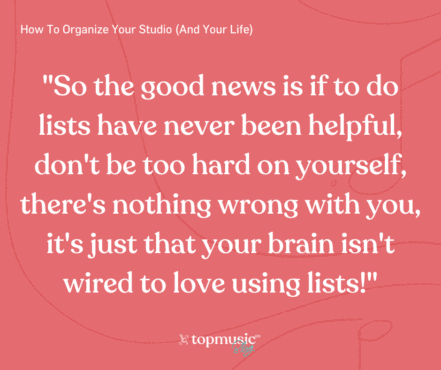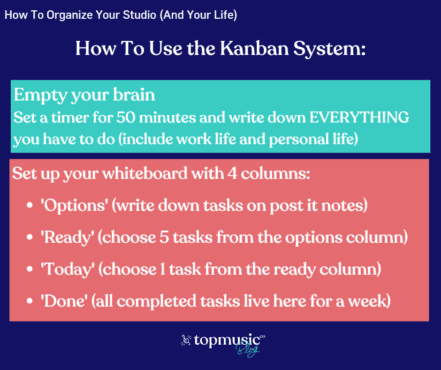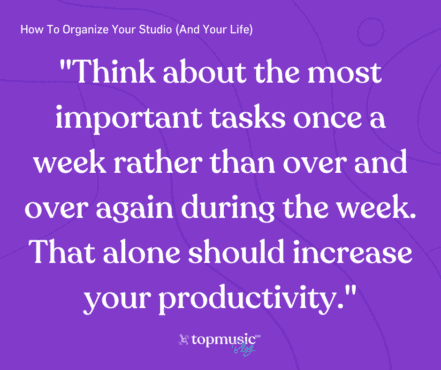If you are like most piano teachers, you have multiple projects you are managing in addition to teaching. You might need to plan summer camps, recitals, and/or group lessons. Managing schedules and music are also part of the mix. And then there are home life obligations. These things are just the tip of the iceberg, right?
What’s a teacher to do? How do you stay organised and on top of everything? I suggest the Kanban system!
Traditionally, advice givers and gurus have said the way to organise your studio and productive was to put together a to do list and keep it updated.
And this might even work for some people.
I’ve tried using them for years and while I have found them to be a useful tool occasionally, for instance if I have a lot of specific tasks that need to get done in a very short period of time, for the most part, they haven’t worked well for me.
I have lots of scraps of paper with to do lists on them.
I write my list down, but then never look at them again (or they get buried under a pile of papers by my computer and I find them months later when I do a purge.)
And I even tried something different a few months ago, I wrote my to do list on a chalkboard, right in view of my computer, filled with things that needed to get done, yet most of that list sits there undone weeks later.
And undone to do lists don’t do a lot of self-esteem (not to mention productivity), do they?
I may have found a better way.
About the same time I tried the chalkboard experiment, I heard about the Kanban system.
You can look it up if you want to learn more about where it came from, but what I found interesting was the tweaking of the system into something I could use.
It is basically a productivity system – an easy productivity system.
To do lists are just that, lists. And for those whose personality type likes ticking things off or following processes, they can work very well.
Yet creative types and visual types don’t do as well with lists because their brains are wired differently.
(So the good news is if to do lists have never been helpful, don’t be too hard on yourself, there’s nothing wrong with you, it’s just that your brain isn’t wired to love using lists!)
Having the big picture when navigating life can be helpful.
To do lists don’t generally give the big picture. But a solution to organise your studio can be created with nothing more than a dry erase board (or even a poster board) and some Post-it notes (I’d recommend the originals even though generic ones might save you some pennies).

Here’s all you need to do:

If you already completed ’emptied your brain’, filling your Options section should be relatively easy.
However, if you are organising for the first time, you would need to break this task down into smaller steps such as research ways to organise, purchase materials for organising, organise music, etc.
In this example, all 3 of these notes could end up in the Ready column in the same week or only 1 or 2 might get moved initially.
TIP: When researching something, set a time limit on your research – 30 minutes is a good length of time for most tasks. The most important thing to remember when setting up your ‘Ready’ notes is that you need to know what ‘done’ looks like for each note. Putting a time limit on tasks that might not otherwise have an obvious ‘done’ is a good way to know when you have completed the task (if you need more time, you can put up another note on another day of course, but by setting a time limit you will also prevent ‘analysis paralysis’.)
If you finish it and have more time you can certainly move another task over and work on that too. But your goal is to complete the one task you choose from the Ready column.
Your reward!

That’s the system.
You might refill the Options section once a week or more or less frequently. By having everything on the board, you can quickly glance at the status of things.
When you move the week’s tasks to the Ready section, you are making decisions about what is most important to get done and the order of importance.
This keeps you from having to make decisions as each task is done. The order has been established, just move down your ready list. Think about the most important tasks once a week rather than over and over again during the week. That alone should increase your productivity.
As teachers, at times it can seem like we have too much to juggle and not enough time to do it all. At times it can be difficult to stay motivated. Or we even have to deal with burnout. I would like to propose that one of the reasons for this is it can be hard to see where we are making progress on a daily basis. Over time, this can lead to discouragement. With this system, it is much easier to see (quite literally) all that has been accomplished in a week which can be very motivating which leads to more productivity. And soon you have an upward spiral of productivity and good feelings!
Additionally, I believe this can be modified to use as a practice tool with students. I haven’t quite worked through all the details but it is in my Options column!
Still looking for more help with being productive and staying on track to meet your goals? Our course ‘Assess, Plan & Execute: How To Get It All Done with Tara Wright’ is designed to guide you through giving your studio a business assessment. This course is available for all Studio and Evolution members of TopMusicPro.
